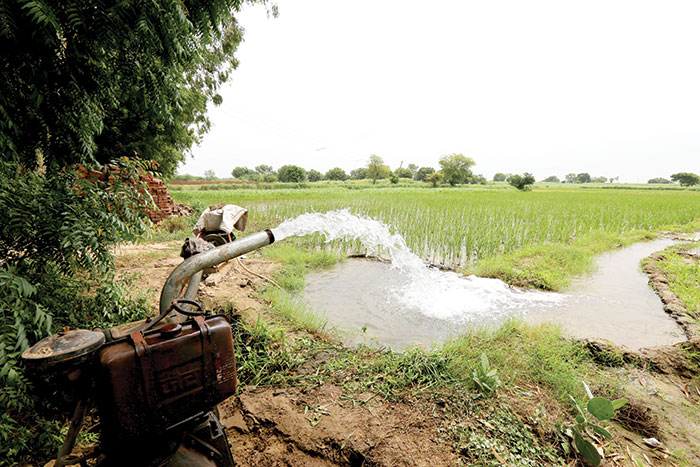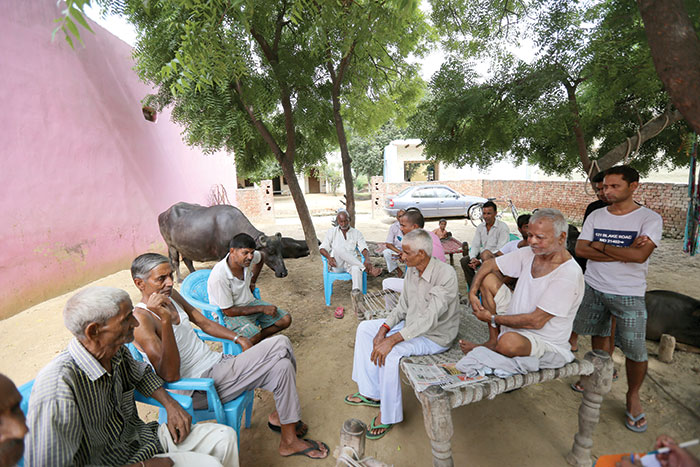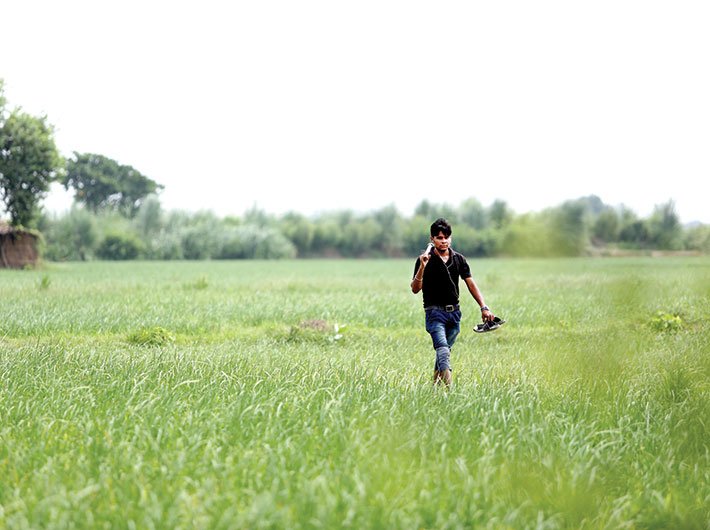The SP government’s handsome deal to farmers who gave up land for the Agra-Lucknow expressway had raised hopes. But farmers giving up land for the Jewar airport don’t expect the BJP government to be as liberal
Ranveer Singh, a 78-year-old resident of Mukeempur Shivara village in the Jewar area, knows exactly what he wants in return for giving up his land for the international airport that is being planned there: four to five times the present circle rate, Rs 20 lakh for rehabilitation, a government job for at least one family member, and a house similiar to and at least as big as the old one he will have to abandon. An apartment won’t do; it’s a house with a compound that he wants. And he wants the authorities to keep all promises and make all payments within six months.
Mukeempur Shivara is one of the nine villages in Jewar, in the Gautam Budh Nagar district of Uttar Pradesh, close to the Delhi-Agra Yamuna Expressway, from which land is to be acquired for the second airport in the national capital region (NCR). Delhi’s Indira Gandhi International Airport (IGIA) handles 63 million passengers yearly, and in the next few years the figure is expected to go up to some 110 million. A second airport would help ease the pressure on IGIA, besides reducing the road trip to the airport for passengers living in Noida, Greater Noida and eastern parts of Delhi.
Plans are to have the airport functioning in seven years, and the Yamuna Expressway Industrial Development Authority (YEIDA), the nodal agency, has started surveying the area. The airport will be developed in public-private partnership, for which a company will be competitively chosen. Land acquisition – a life-changing proposition for the many farmers of Jewar – is expected to begin by November.
 Banwaribas (right), which will give way to tarmac
Banwaribas (right), which will give way to tarmac
“The project will need 3,000 hectares. In the first phase, we need to acquire 1,000 hectares within a budget of Rs 2,000 crore. The total project cost is estimated at Rs 15,000 crore to Rs 20,000 crore,” says YEIDA CEO Arunvir Singh. When the project was first proposed in 2001, YEIDA had roughly marked out some 10,000 hectares in 35 villages for the project. Key no-objection certificates for construction to begin are already in place. Mukeempur Shivara (where Ranveer Singh lives), Kishorepur, Banwaribas, Rohi, Ramner, Nagla Ganeshi, Nagla Prachi, Nagla Safi Khan and Ranhera are the villages to be acquired in the first phase.
What’s a good deal?
Actually, farmers here have no problem in giving up their land for the airport. They have seen their counterparts in Noida get cash-rich from selling agricultural land to builders and then prosper from investing in business or entering into real estate business themselves. While sale to government may not bring such huge returns, they don’t seem unhappy to agree to a “handsome deal” –the reference is to the acquisition by the previous Samajwadi Party government of 3,000 hectares of fertile land for the six-lane Agra-Lucknow expressway project without as much as a murmur of dissent. The government of then chief minister Akhilesh Yadav had straightaway offered four times the circle rates for those surrendering their land for the expressway project – and the farmers had seen it as a really good deal.
Arunvir Singh says YEIDA is now offering Rs 1,895 per square metre in Jewar, where land has been classified as ‘urban’. This is 2.5 to 2.75 times the present circle rates (Rs 650-750 per square metre). Besides, farmers will get a house and Rs 5 lakh toward rehabilitation. It is this that Ranveer Singh and others like him contest. They are aware that, under land acquisition rules, the government can negotiate with them, though it may not indulge them if their demands are excessive. By driving a hard bargain and using some political leverage, they know they can reasonably expect to get more than what are being offered.
Trilok Ranjan Sharma, head of Banwaribas village, says farmers do not have any issue in giving up their land provided the perks are good. “We have been waiting for the project to take off for the past two decades. There is hue and cry for an airport here since 2001, and due to this, I haven’t done any construction in my house, knowing that I’ll one day have to sell off my land. It’s good the airport has now got a nod.” Like Ranveer Singh, Sharma too is not satisfied with what YEIDA offers. “Two times?” he asks. “Not one of us farmers will be willing to sell at that rate.”
Sunil Kumar, of Ramner village, a Std XII passout, owns 15 bighas of land that he is not willing to give up unless the compensation is good enough. “We’ll be landless,” he says. “Can you imagine what that means? We will have to leave our birthplace. Think about those who don’t have land and work as farmhands. They won’t even get homes as part of compensation because right now they live in kucha houses near the fields. And they will lose their jobs too.”
It’s also about losing touch with familiar mores, familiar people. “I want Shashi to continue to be my neighbour in the new place where we are relocated. We don’t want to get scattered. Also, my house must be as big as, and similar to, the one I have now. I don’t want to live in flats,” says Kamlesh Mati, from Mukeempur Shivara. And Sudarshan Singh, of Ramner, asks, “Where will we keep our buffaloes? On the fourth floor of a 2-BHK flat that the government will give us on the banks of a river?”
The Bhatta-Parsaul nightmare
If the farmers remember the deal the Akhilesh government gave some of them, they also remember what happened when the Bahujan Samaj Party government, led by Mayawati, tried to bludgeon through a deal with farmers for the Agra-Delhi expressway. Land was to be acquired from Bhatta, Parsaul, Karauli, Dayanavpur, Sabauta and some other villages. Farmers of Bhatta and Parsaul had taken to the streets in protest against the 2011 ordinance, there was violence and police action. Eventually, a deal was settled: farmers were to be paid about three times the circle rates. But payments are yet to be received, making farmers like Ranveer Singh and Sharma wary and insistent that all payments must be completed within 45 days of their giving up land for the project.
Jewar MLA Dhirendra Kumar, who as a Congress member had joined the Bhatta-Parsaul protests but is now with the BJP, says payments are pending because some of the farmers have filed cases. “Mayawati initially purchased the land from those who gave it up. Then she acquired at higher rates from those who were not ready for mutual agreement. As the compensation given to those who protested was higher, the former went to court seeking more compensation. As the matter was pending in court, payments too are pending. Now, the court has ordered that everyone will receive compensation at the same rates,” he says.
Mahesh Kumar, of Sabauta village, lost three bighas to the Agra-Delhi expressway, but is yet to receive 64 percent of what was promised. Says Roshan Singh, a farmer of Ramner whom villagers look up to because, as a former Class II employee of the state government, he knows how government departments work: “The money Mayawati promised is yet to be paid. Some farmers have only received 40 percent of the payment so far. Some have received 60 percent. They were all rehabilitated in small houses on the periphery of the city. Can you imagine the life of a farmer who has lost his land and now has nothing to do in a single storey house?”
Amit, a 25-year-old farmer of Ramner, like many young farmers like him, has crorepati dreams, used as he is to seeing the SUV-driving, bling-flashing sons of farmers who sold huge tracts in Noida. He believes he will be a crorepati once his 16 bighas are sold. “We want '50 lakh per bigha, plus a big house in the city,” he says. “Roshanji will fight for us. We’ll send him to negotiate with the government.”
 Villagers of Mukeempur Shivara discuss how to get a good deal from the state government
Villagers of Mukeempur Shivara discuss how to get a good deal from the state government
Residents of most of shortlisted villages have little hope from the Yogi Adityanath government. “We don’t expect the Yogi Adityanath government to do much,” says Shankar Singh, of Kishorepur. “I’m even ready to stage protests. Because, for Yogiji, the widows are now married and mothers of two kids... for Yogiji, the handicapped are now running marathons and the elderly are now young. This is why he has ended pensions for all these categories of people. It’s his insensitivity that makes me think there’s not much to hope from him.”
The development game
One of the drawbacks of Noida – and it has many – is that the existing airport is about 35 km away and the route passes through traffic-laden Delhi, which means it can take two hours or more to reach the airport. In comparison, Gurugram fared really well as a satellite town to Delhi because reaching the IGIA is easy. Successive governments in Uttar Pradesh have been aware of this and planned for an airport here as early as during Rajnath Singh’s time as chief minister. The project has finally taken off, and builders have started investing heavily around Jewar. Though a recent slump in the property market has led to inventory pile-ups, the final nod to the airport will surely hike property prices in Noida, Greater Noida and around Jewar.
Deepak Kapoor, president, western UP chapter of the Confederation of Real Estate Developers Association of India (CREDAI), says infrastructure development is directly related to the growth of real estate and hence the airport in Jewar will give a much-needed push to the demand for properties in Noida, Greater Noida and other places in the region. “An airport in this region was a long-pending demand. Those who come from Agra or want to visit the city will not need to go to IGIA. With the increase in the reach of metro rail, the real estate scenario in Noida and Greater Noida will improve. With the coming of the international airport, there will be residential, commercial, industrial and institutional growth in the area. A lot of corporates would now look at Greater Noida, as it will now have dual advantage of better connectivity and better-planned location,” he says.
Metro connectivity is also being promised. The Greater Nodia metro line is expected to be extended to the airport in Jewar; besides, an elevated metro line from IGIA to Jewar is also planned. “Metro links will further increase business opportunities here in Greater Noida and also in Jewar,” says Rajpal Kaushik, another YEIDA official involved in the Jewar airport project.
Jewar flight schedule
2001: Rajnath Singh-led BJP government in UP proposes airport in Jewar
2003: Centre grants site clearance
2004: Since BJP is not longer in power in UP, the plan is set aside
2008: The UP government submits a techno-economic feasibility report (TEFR), which the centre does not approve
2010: CM Mayawati renames it the 'Taj International Aviation Hub', refurbishes plans, but it still fails to get clearance
2012-16: The Samajwadi Party comes to power. Its government proposes two airports, in Jewar and in Agra
March 2016: State government submits fresh application to centre for airport at Jewar
June 2017: New CM Yogi Adityanath sends another report to centre, which finally gives in-principle site clearance
“Employment opportunities will follow development,” says MLA Dhirendra Kumar. “The government already has a plan of making an international Formula 1 racing track next to the proposed site of the airport. The adjacent cities, significantly Agra, Mathura and Aligarh, will attract tourists.” He believes that the airport will change lives and lifestyles around Jewar, the way it has happened in Gurugram.
Will the demands of all farmers in Jewar be met before those dreams of swank and swag materialise? “People can ask for the moon, but we can’t give it to them,” says Dhirendra Kumar. “We will follow the norms. Banwaribas is a village, so people there will get four times the present circle rate while in Ranhera, Shivara and other villages, which are categorised as urban, the rates will be two times the circle rates.”
But the villagers are unwilling to listen to that argument. As Tejpal Singh, a former village head, who with his two brothers owns 250 bighas, puts it: “Till the child cries, the mother doesn’t give it milk. If we ask for 50, they’ll pay us 40-45. Land is life to us, we are giving up something as precious as life. They’ll have to give us at least that much.”
ishita@governancenow.com
(The article appears in the September 30, 2017)

